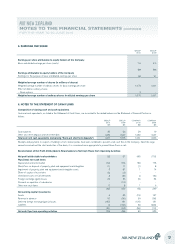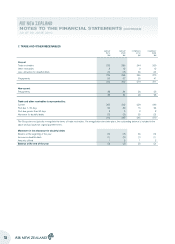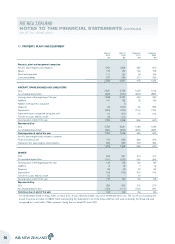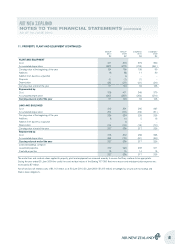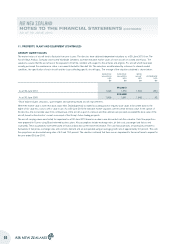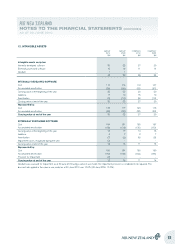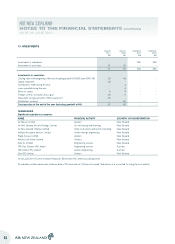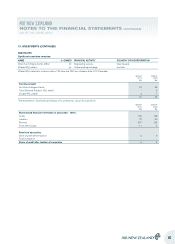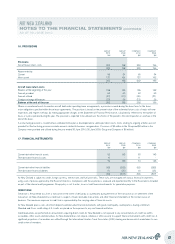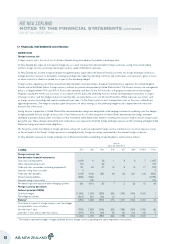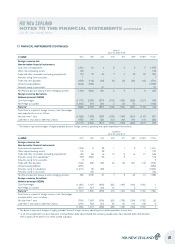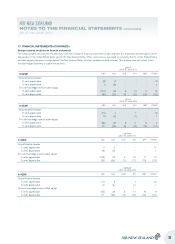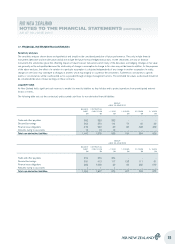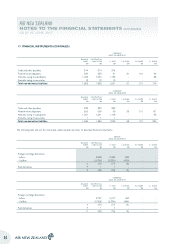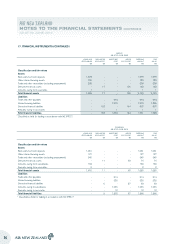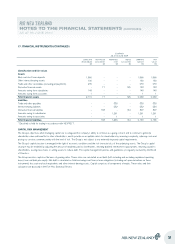Air New Zealand 2010 Annual Report Download - page 29
Download and view the complete annual report
Please find page 29 of the 2010 Air New Zealand annual report below. You can navigate through the pages in the report by either clicking on the pages listed below, or by using the keyword search tool below to find specific information within the annual report.
16. PROVISIONS
GROUP
2010
$M
GROUP
2009
$M
COMPANY
2010
$M
COMPANY
2009
$M
Provisions
Aircraft lease return costs 202 198 202 196
202 198 202 196
Represented by:
Current 65 34 65 34
Non-current 137 164 137 162
202 198 202 196
Aircraft lease return costs
Balance at the beginning of the year 198 143 196 142
Amount provided 64 60 63 59
Amount utilised (47) (31) (45) (31)
Foreign exchange differences (13) 26 (12) 26
Balance at the end of the year 202 198 202 196
Where a commitment exists to maintain aircraft held under operating lease arrangements, a provision is made during the lease term for the lease
return obligations specified within those lease agreements. The provision is based on the present value of the estimated future costs of major airframe
inspections and engine overhauls by making appropriate charges to the Statement of Financial Performance, calculated by reference to the number of
hours or cycles operated during the year. The provision is expected to be utilised over the shorter of the period to the next inspection or overhaul or the
end of the lease.
A restructuring provision is created where a detailed formal plan is developed and a valid expectation exists. Costs relating to ongoing activities are not
provided for. Restructuring provisions include amounts related to business reorganisation. Provisions of $4 million in the Group and $2 million in the
Company were provided and utilised during the year ended 30 June 2010 (30 June 2009: Group and Company of $6 million).
17. FINANCIAL INSTRUMENTS
GROUP
2010
$M
GROUP
2009
$M
COMPANY
2010
$M
COMPANY
2009
$M
Current derivative financial assets 62 143 63 143
Term derivative financial assets 10 - 11 -
72 143 74 143
Current derivative financial liabilities (62) (282) (62) (282)
Term derivative financial liabilities (1) (25) (1) (25)
(63) (307) (63) (307)
Air New Zealand is subject to credit, foreign currency, interest rate, and fuel price risks. These risks are managed with various financial instruments,
using a set of policies approved by the Board of Directors. Compliance with these policies is reviewed and reported monthly to the Board and is included
as part of the internal audit programme. Group policy is not to enter, issue or hold financial instruments for speculative purposes.
CREDIT RISK
Credit risk is the potential loss from a transaction in the event of default by a counterparty during the term of the transaction or on settlement of the
transaction. Air New Zealand incurs credit risk in respect of trade receivable transactions and other financial instruments in the normal course of
business. The maximum exposure to credit risk is represented by the carrying value of financial assets.
Air New Zealand places cash, short term deposits and derivative financial instruments with good credit quality counterparties, having a minimum
Standard and Poors credit rating of A. Limits are placed on the exposure to any one financial institution.
Credit evaluations are performed on all customers requiring direct credit. Air New Zealand is not exposed to any concentrations of credit risk within
receivables, other assets and derivatives. Air New Zealand does not require collateral or other security to support financial instruments with credit risk. A
significant proportion of receivables are settled through the International Aviation Travel Association (IATA) clearing mechanism which undertakes its own
credit review of members.
AIR NEW ZEALAND
NOTES TO THE FINANCIAL STATEMENTS (CONTINUED)
AS AT 30 JUNE 2010
27


